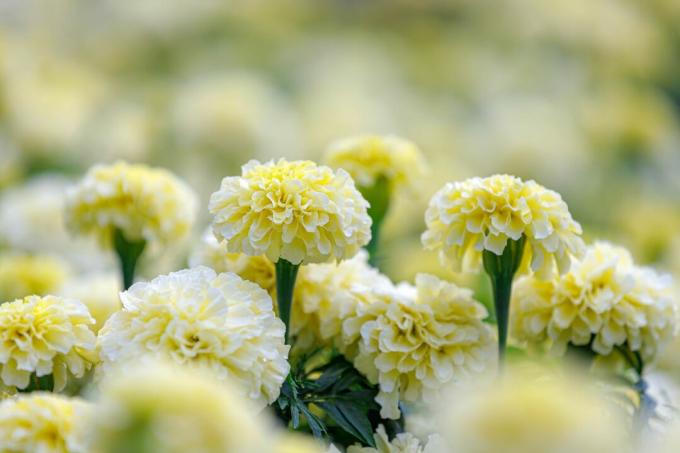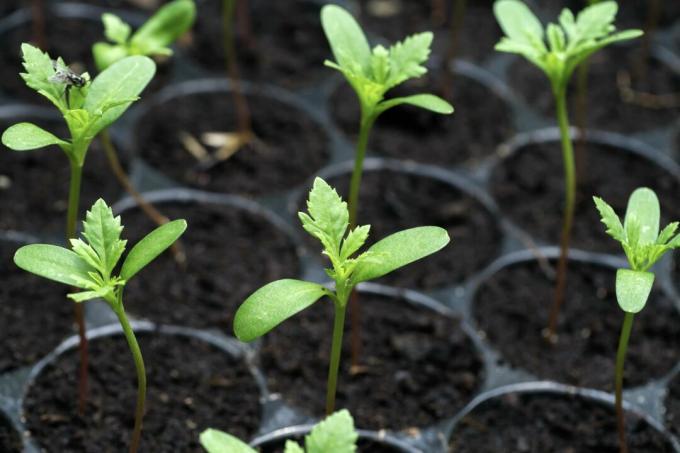Tagetes can be found in many gardens as a rich flowering ornamental plant. Find out what other uses the marigold has and how to cultivate it successfully here.

Tagetes are not only attractive flowering plants, they are also edible and repel pests. We will introduce you to the marigold and give you tips on the choice of species and varieties, as well as on cultivation and use.
"Contents"
- Tagetes: flowering time, origin and characteristics
- The most beautiful Tagetes varieties and species
-
Planting marigolds: location, sowing and pricking out
- The right location for marigolds
- Marigold planting time
- Sow marigolds
- Prick the marigolds
- Care of the marigolds
- Propagate marigolds
- Is the marigold hardy?
- Tagetes against pests
- Use in the kitchen: is the marigold edible?
Tagetes: flowering time, origin and characteristics
Marigolds (Tagetes) belong to the Asteraceae family and originally come from northern Central America, mainly from Guatemala and Mexico. The genus is estimated to have around 50 to 60 species, some of which are grown here as annual ornamental plants. Tagetes are also known as velvet flowers or Turkish carnations. On the day of the dead, the famous Mexican festival of the dead, the orange marigold is used as an ornament for flower garlands and graves. This is where another name comes from: flower of the dead.
Tagetes are annual or perennial plants that can grow upright or bushy. Depending on the type and variety, they can be between 20 cm and 3 m high. Tagetes usually have pinnate, dark green leaves, which often smell tart and aromatic. The flowering period of the Tagetes usually begins in June and lasts until October, but some species do not flower until autumn. The simple to double flowers are grouped in panicles or individually on long flower stalks. They can be colored yellow, orange, red or white, but are very often multicolored. After pollination, the elongated seeds of the marigold, the so-called achenes, form. And as it is typical for composites, as well as the dandelion (Taraxacum officinale), they also form a kind of elongated, white parachute: the pappus.
Are marigolds friendly to bees? The unfilled flowers of marigolds in particular attract bees and other pollinating insects. In midsummer, the newly blooming marigolds are a welcome source of food.

The most beautiful Tagetes varieties and species
There are many ornamental and edible species among the marigolds. In our gardens are mostly Tagetes erecta-Hybrids and Tagetes patula, increasingly too Tagetes tenuifolia planted. We will introduce you to the most important species and their most beautiful varieties.
- Upright marigold (Tagetes erecta): Annual marigolds with a stature height of 30 to 80 cm. The flower heads are often very large and have many petals. However, there are also varieties with simple flowers. This also includes the dye tagetes, whose orange flowers used to dye wool and food yellow. Many varieties are hybrids and as Tagetes x erecta marked. Popular varieties are, for example, the white Arctic ’marigolds or the dwarf shapes Strawberry Blonde’ and Bolero ’marigolds with a height of just 20 cm.
- Licorice Tagetes (Tagetes filifolia): The bushy licorice tagetes, which grows about 20 cm high, forms numerous, narrowly pinnate, sweet and licorice-like tasting leaves. It forms tiny, white, inconspicuous flowers in autumn.

- Lemon Tagetes (Tagetes lemmonii): Perennial Tagetes species with a height of around 40 cm. It blooms very late from autumn and in winter quarters into spring. Leaves and flowers are edible and have a spicy, lemony-sweet aroma.
- Yauthli or winter tarragon (Tagetes lucida): Perennial marigold with an intense aroma of tarragon, aniseed and fennel. The yellow one Tagetes lucida becomes about 80 to 100 cm high and is hardy down to about -6 ° C. The Aztecs already used the herb to flavor dishes and for religious rituals.

- Giant Spiced Tagetes (Tagetes minuta): Up to 300 cm high marigold with very large, pinnate leaves that smell of citrus fruits. It is also known as huacatay and is used as a spice in various Mexican dishes.
- Low marigold (Tagetes patula): Tagetes species that remain small and are 20 to 25 cm tall. Here too, hybrids are often used in the form of Tagetes x patula offered. The Tagetes ‘Carmen’ shows deep orange-red, double flowers, while other varieties, such as ‘Mr. Majestic ’, form simple, yellow-red striped petals. ‘Bambino’ forms two-tone flowers in yellow and orange, while ‘Durango Red’ shows cherry-red, double flowers. Tagetes patula is particularly effective against harmful nematodes.
- Narrow-leaved marigold or spice tagetes (Tagetes tenuifolia): Approximately 40 cm high Tagetes species with small, pinnate leaves and numerous simple flowers. Both are edible and offer a refreshing citrus aroma that varies between lemon, tangerine and blood orange, depending on the variety. Snails are not very attracted to this species and they are often spurned. Varieties such as ‘Starfire’, ‘Lemon Gem’ and ‘Luna Orange’ convince with a multitude of small flowers in light yellow, orange or red.

Planting marigolds: location, sowing and pricking out
Tagetes are ideal for planting balcony boxes, as a mixed culture in vegetable beds or as a flowering, low bed border. A planting distance of 20 to 30 cm to other plants should be maintained. If you plant marigolds in groups, the distance between the plants is about 15 to 20 cm. In the following, you will find out what else you should pay attention to when planting marigolds.
The right location for marigolds
Tagetes prefer a sunny to partially shaded, warm location. They thrive very well in well-drained, humus-rich garden soils. For the planting of pots and window boxes, a loose, nutrient-rich potting soil like ours should be used Plantura organic potting soil, be used. With its high compost content, this saves moisture and releases it to the plant roots when required. In addition, the nutrients it contains provide the young marigolds with everything they need in the first few weeks after planting.

Marigold planting time
Tagetes are frost-sensitive, annual or rarely perennial plants. They are therefore first placed on a warm window sill and only put outside from mid-May after the ice saints.
Sow marigolds
Marigolds are grown from seeds so that they can be put outside as young plants in May. With the help of a preculture on the warm, light window sill, they will bloom as early as June. Alternatively, sow the seeds directly outside in May. However, these plants will only start flowering much later. The marigold seeds for the preculture are sown between January and March. Fill a suitable cultivation container with nutrient-poor sowing compost and apply the seeds on the surface. Now moisten the soil well. Marigold flowers are light germs, so their seeds are hardly covered with earth and only pressed down well. At 18 to 20 ° C and sufficient moisture, the seeds need about two to three weeks to germinate.
Sow marigolds as green manure: In a species-rich flowering mixture, the annual marigold can also be sown as a green manure to improve the soil or as a bee pasture. The robust spice tagetes are best suited for this Tagetes tenuifoliawhich, with its numerous, simple flowers, provides food for pollinating insects. So that the marigolds still bloom, they should be sown directly outside from April.
Prick the marigolds
As soon as the seedlings develop the first true leaves, i.e. pinnate leaves, they can be pricked out and put into individual pots. With the exception of the dwarf forms, the plants are then about 5 to 8 cm in size. In order to promote growth, the marigolds are now converted into nutrient-rich potting soil. With a prick stick, moving is easy and without serious damage to the root or seedling.

Care of the marigolds
Marigolds are generally easy to care for. Immediately after planting, however, it is advisable to put on a snail cover, because the voracious mollusks love marigolds. In summer, they must be watered regularly, especially in planters on the terrace and balcony. However, never water the plants overhead, as the moisture promotes fungal diseases. Especially opposite Gray mold (Botrytis cinerea) Tagetes are often sensitive. Sick plant parts and plants should therefore be removed. You can achieve a good supply of nutrients and long-lasting blooms with the help of an organic liquid fertilizer like ours Plantura organic flower & balcony fertilizer. This is applied together with the irrigation water and in this way washes the nutrients directly to the roots. In order to encourage the plant to continuously develop new flowers, you can cut out the faded flower heads over and over again during the summer. In this way, the flowering time of the marigold can be extended by a few weeks.
tip: The leaves of the marigold and especially the sap can be damaged by sensitive people after skin contact and exposure to sunlight rashes with blistering - a so-called phototoxic contact dermatitis - trigger. It is therefore best to always wear gloves when planting and cutting marigolds.
Propagate marigolds
Tagetes are propagated from seeds. In autumn seeds of the marigold can be obtained. Although these are not true to type, they are very easy to collect and store. Annual marigolds begin to wither and wither in late autumn. Cut the brown seed heads from these plants between September and October. They are allowed to dry in the house for a few weeks at room temperature. Then free the seeds from the flower pods and store them in a dark, dry and cool place. If stored in this way, marigold seeds can germinate for several years.

Is the marigold hardy?
Tagetes are generally not hardy. Annual species die in autumn anyway. Perennial marigolds, such as Tageteslemmonii and Tagetes lucida, are only partially hardy, because they can only tolerate low freezing temperatures. These species must be overwintered frost-free, cool and light in the winter garden, greenhouse or garden shed. Throughout the winter, marigolds should only be watered sparingly to prevent mold growth.
Tagetes against pests
In addition to the citrus-like fragrances, marigolds produce other compounds that they release into the soil via their roots. These root exudates drive away soil-borne pests, such as harmful species of Nematodes, very effective. Together with the one that also drives away nematodes Marigold (Calendula officinalis) they should therefore not be missing in any vegetable patch. In the greenhouse, marigolds are used as underplanting Whitefly (Aleyrodidae). In a Mixed tomato culture therefore they fit in perfectly and at the same time attract pollinators to the tomato blossom with the attractive flowers.

Use in the kitchen: is the marigold edible?
The marigold is edible and the flowers and leaves of the marigold are also important in herbal medicine. Flowers of the Tagetes patula are used against night blindness, hiccups and diarrhea. Spice mixtures or teas are made from the parts of the plant, which have an aromatic scent of citrus plants. In addition to an edible ornament on the plate, the flowers are also good coloring agents for rice or baked goods.
A close relative of the marigold is the zinnia (Zinnia). We will introduce you to the most beautiful varieties of the popular annual summer flower and give you tips on sowing, care and propagation.
